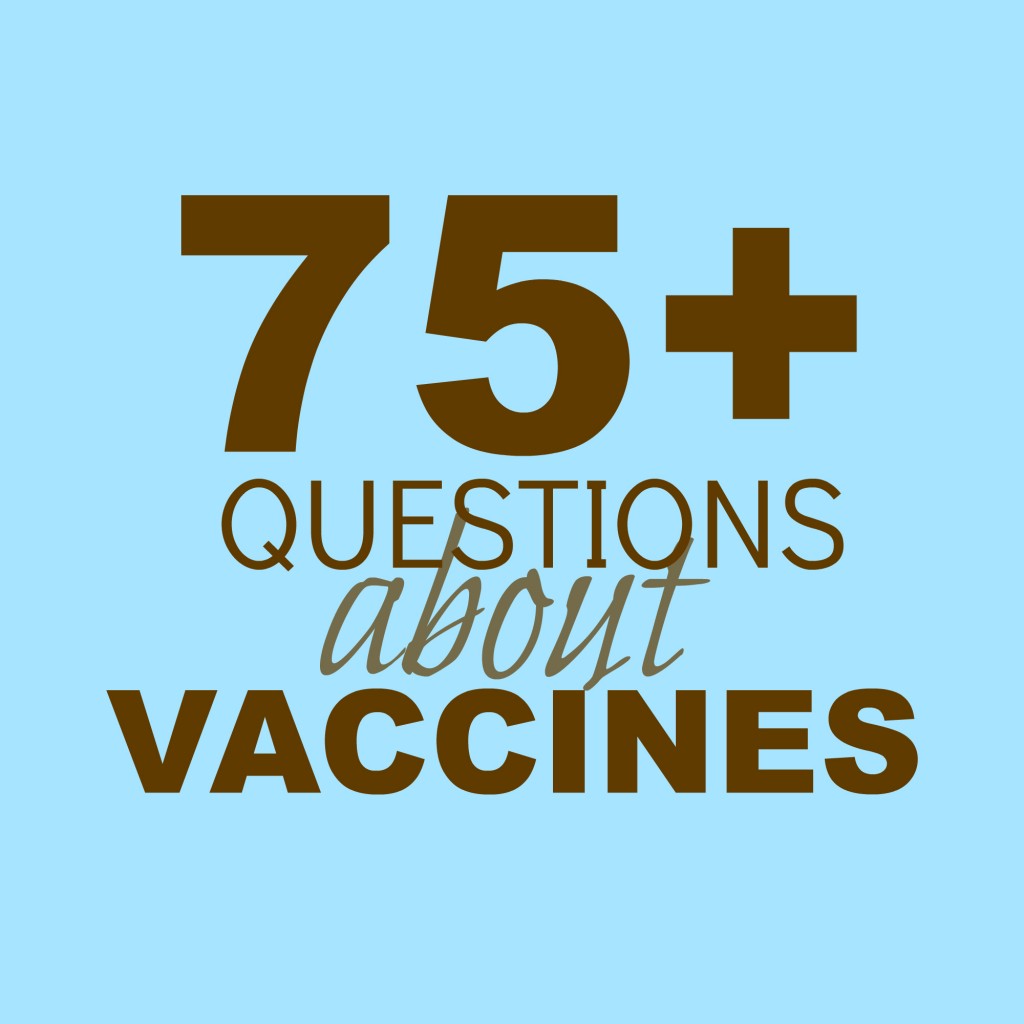 I don’t normally get controversial here on the blog but some things weigh heavily on my heart and this is one of them. I’m concerned by the growing number of people who are angrily shouting “You dumb anti-vaxers with your pseudo-science! You’re killing everybody else with your stupid refusal to vaccinate!”; they are so blinded by their anger (fueled by media reports funded by pharmaceutical companies) that they don’t stop, take a breath and listen to actual facts. Well at any rate, that’s the impression I get from their ranting internet comments.
I don’t normally get controversial here on the blog but some things weigh heavily on my heart and this is one of them. I’m concerned by the growing number of people who are angrily shouting “You dumb anti-vaxers with your pseudo-science! You’re killing everybody else with your stupid refusal to vaccinate!”; they are so blinded by their anger (fueled by media reports funded by pharmaceutical companies) that they don’t stop, take a breath and listen to actual facts. Well at any rate, that’s the impression I get from their ranting internet comments.
First of all, I’m not technically an “anti-vaxer”. My children have been partially vaccinated on a delayed schedule and I myself have had at least one vaccine as an adult. I do believe strongly, however, that vaccines carry an inherent risk and that every parent should have the freedom to decide if they want their children to take that risk or not. There are valid, logical, science-based reasons why some parents choose not to vaccinate, and I think everybody needs to take a step back and acknowledge that truth.
So here we go. Five indisputable facts about vaccines:
1. Vaccines Contain Toxic Ingredients
A vaccine does not contain merely the active vaccinating ingredient (i.e., a virus in some form or other) and the culture media required for its development, it also contains additional ingredients that are intended to either increase the effectiveness of the vaccine, or to stabilize and preserve it. The CDC has published a little booklet called “The Guide to Vaccine Contraindications and Precautions“, for your perusal. Among other things, this booklet informs you of all the known ingredients in the vaccines currently available today. Here are a few selections detailing some of the ingredients in commonly administered vaccines, copied and pasted directly from the book: DTaP (Daptacel) - Aluminum Phosphate, Ammonium Sulfate, Casamino Acid, Dimethyl-beta-cyclodextrin, Formaldehyde or Formalin, Glutaraldehyde, 2-Phenoxyethanol, Aluminum Hydroxid MMR (MMR-II) - Amino Acid, Bovine Albumin or Serum, Chick Embryo Fibroblasts, Human Serum Albumin, Gelatin, Glutamate, Neomycin, Phosphate Buffers, Sorbitol, Sucrose, Vitamins Pneumococcal (Prevnar) - Aluminum Phosphate, Amino Acid, Soy Peptone, Yeast Extract Rotavirus (RotaTeq) - Cell Culture Media, Fetal Bovine Serum, Sodium Citrate, Sodium Phosphate Monobasic Monohydrate, Sodium Hydroxide Sucrose, Polysorbate 80 Other vaccines have very similar lists. To sum up, vaccines contain a cocktail of the following ingredients:
- Antibiotics
- Aluminum
- Animal and Human Cells, including from monkeys, chickens, cows, and aborted human fetuses
- Formaldehyde
- MSG
- and of course, the infamous Thimerasol
Additional facts for your consideration:
- It’s important to know that in order to protect the trade secrets of vaccine manufacturers, they are only required to disclose inactive ingredients “when a safety factor”. One would assume that vaccine manufacturers abide by this stipulation, and therefore those undisclosed ingredients should fall under the category of “Generally Recognized as Safe” by the FDA. Unfortunately, potential allergens and other ingredients many people choose to avoid are considered GRAS by the FDA, and thereby could be included in vaccines without anyone’s knowledge. One can only speculate about potential additional ingredients, but let’s stick to the facts, which are: there are additional unlisted ingredients in vaccines.
- Another fact to consider is that by utilizing animal and human tissue for the development of vaccines, a whole assortment of various contaminants can potentially find their way into vaccines. The FDA has discussed the difficulty of ensuring that “adventitious agents” do not make their way into the final vaccine product. This is a valid concern because it has actually happened on several different occasions, the contamination of the polio vaccine with SV40 being the most infamous. Of course, vaccine manufacturers do their very best to ensure that such things don’t happen; but consider how difficult it would be to effectively test every batch of a vaccine, in each step of the process, for any number of known and unknown pathogens and other undesirable materials. The fact is: developing vaccines with animal and human tissue increases the risk of “adventitious agents” finding their way into vaccines.
- The CDC and FDA and all vaccine manufacturers insist that the majority of these ingredients are present only in trace amounts, but keep in mind that a child following the CDC schedule will have received 16-18 shots by the time they are 6 months old. Those trace amounts (of multiple toxins and other potentially dangerous ingredients) add up quickly at that rate. Those who say a child could encounter that much or more of the same toxins environmentally fail to take into consideration that these toxins are injected into the bloodstream, bypassing the body’s natural defenses.
My Conclusion: I go to great lengths to ensure that my children eat a healthy diet that is as free as possible of GMO’s, pesticides, artificial colors, artificial flavors, preservatives, refined sugars, and refined flours. I purchase only grass-fed pastured meats and dairy products to avoid overexposure to antibiotics and hormones. I avoid antibiotics as medication whenever possible. In fact, I avoid pretty much all medication, finding instead that natural remedies are at least as effective as the pharmaceutical options. I also breastfed both of my babies, avoiding introducing food until they were at least 6 months of age, and continued to breastfeed as long as I could. In short, I do everything I can to reduce my family’s exposure to chemicals and toxins to the extent it is possible. Based on this working philosophy, why would I intentionally repeatedly inject the very ingredients I otherwise work diligently to avoid, into my infants’ developing body? To do so would contradict all my efforts to ensure their maximum health.
2. Vaccines Can Have Serious Side Effects
Most doctors will say when pressed that vaccines typically only trigger mild side effects or reactions, such as slight swelling at the injection site, a mild rash or a low fever. Those are indeed the most common reactions/side effects, but that does not mean they are the only ones. On the contrary, a brief skimming of a vaccine insert will reveal that at least two pages are required to list and explain all the possible side effects of each vaccine. If your doctor didn’t offer you a chance to read through the vaccine insert before injecting your child, you can access the information readily online from each manufacturer’s website. Here’s a partial listing from some of the more common vaccines: MMR - Atypical measles; fever; headache; dizziness; malaise; irritability; pancreatitis; diarrhea; vomiting; nausea; diabetes mellitus; anaphylaxis and anaphylactoid reactions; arthritis; encephalitis; Guillain-Barré Syndrome; febrile convulsions; pneumonia; otitis media; conjunctivitis DTaP - Cyanosis; injection site pain; injection site rash; injection site nodule; injection site mass; cellulitis; febrile convulsion; grand mal convulsion; partial seizures; screaming Polio - lymphadenopathy; convulsion; febrile convulsion; headache; paresthesia; and somnolence Additional facts for your consideration:
- The Department of Health and Human Services maintains a Vaccine Adverse Event Reporting System that catalogs all submitted vaccine reaction reports. All reactions deemed “serious” are reviewed by medical experts; and from October 2011 to August 2013, on average, 870 serious adverse event reports were filed per month. The CDC is the first to admit that one of the main limitations of VAERS is underreporting, meaning that the actual numbers of serious adverse events are significantly higher. How much higher? It’s impossible to know for sure, given the variables, but the FDA surmises that in some cases, as little as 1% of adverse reactions to medications are reported to MedWatch, the pharmaceutical product counterpart to VAERS. In the same publication, they mention that the British passive reporting system estimates underreporting to be anywhere from 2-10%. So let’s go with the highest estimate of 10%, and that means that if an average of 870 serious adverse events are reported to VAERS each month, then in all likelihood, there are at least 8700 serious reactions each month.
- Another limitation of VAERS is that anyone can report an adverse event, including parents of affected children. You might assume, therefore, that the database would be rife with inflated reports from militant “anti-vaxers”. However, the DHHS confirms that the majority of reports (83%) are actually filed by vaccine manufacturers, health professionals, and state immunization programs. Only 7% are reported by parents, and the remaining 10% are “other sources”.
- The National Vaccine Injury Compensation Program (more on that establishment in a minute) has awarded more than two and a half BILLION dollars for vaccine-related injuries and deaths since 1989.
- Autism and developmental disabilities, food allergies and asthma, Type 1 diabetes, and other autoimmune diseases have all dramatically risen in number in the past couple decades. Coincidentally, the number of vaccinations has also risen dramatically. When confronted with this fact, many people say, “Correlation does not equal causation”. In other words, just because those two numbers rose concurrently does not mean the one caused the other. Interestingly, the same people will say that vaccination eradicated smallpox worldwide and polio nationwide because the decline of those diseases coincided with the increase in vaccination against them. If that is not a correlation/causation argument, then what is? Furthermore, such an argument fails to take into consideration other factors involved in the eradication of disease, namely, clean water, healthy nutrition, good hygiene, and excellent medical care. It also fails to take into consideration that cholera and typhoid disappeared in this country without the help of vaccination programs. It also fails to take into consideration that all infectious diseases -including those we currently vaccinate against - were on the decline from 1900 on, and were already well on their way out the door prior to the vaccinations that began in the forties. A fascinating study on infectious diseases (and other causes of death) during the twentieth century was conducted at the end of the last century and can be found in its entirety here. Of particular interest is Figure 4, which shows that measles, polio, and pertussis all declined rapidly during the first half of the century, and that trajectory merely continued. To say that vaccination alone caused the decline of those diseases is patently false. Now, back to our correlation/causation argument: I think it is safe to say in both instances that vaccines played a part, both in the eradication of infectious disease, and the rise of autoimmune and other diseases. One final thought on this matter: correlation does not equal causation… but does it disprove it? Hardly. Rather, it indicates a potential connection that must be explored.
My Conclusion: The risk of vaccination is incredibly high. The potential side effects and possible reactions are enough to give me pause, especially considering that is the main reason I avoid most pharmaceutical medication in the first place. I prefer remedies with few to no side effects for the treatment (and prevention) of disease.
3.Vaccine Manufacturers are Not Held Accountable For Vaccine Injuries
Due to increased concerns from parents whose children suffered serious side effects from vaccinations, and resulting lawsuits and liability costs, the National Childhood Vaccine Injury Act was passed into law in 1986. Several measures took effect with the law, including the aforementioned VAERS, but the key element was this:
(1) No vaccine manufacturer shall be liable in a civil action for damages arising from a vaccine-related injury or death associated with the administration of a vaccine after October 1, 1988, if the injury or death resulted from side effects that were unavoidable even though the vaccine was properly prepared and was accompanied by proper directions and warnings.
This is astonishing, considering that any other type of pharmaceutical manufacturer can be sued by anyone who is injured by their medication. Medical malpractice laws protect patients from negligent and inept practitioners. If you or your child is injured by a vaccine (and as we have discussed, this happens with alarming regularity), your only recourse is to file a claim with the National Vaccine Injury Compensation Program. From there, your claim is passed around to a few legal and medical experts, who add their reports to your file, which ends up in the hands of a “special master”. The special master is a lawyer who decides if the claim is worthy of compensation or not, and if so, how much. No trial, no judge, no jury. Just one lawyer who decides whether or not your case is solid. If your claim is determined to be eligible for compensation, guess where the money comes from? Not the manufactures! Oh, no, they don’t give a dime to those injured by the vaccines. The money comes from a tax excised on all vaccinations, so the injury compensation is actually paid for by the people (or their insurance companies) receiving the vaccinations. If your claim is denied by the VICP, then you may file a civil lawsuit under certain conditions.
My Conclusion: I believe strongly that all manufacturers should be held responsible for their products and the claims they make regarding their product. This means that anyone affected by a vaccine should have the freedom to sue the manufacturer in a court of law. If vaccine makers are not held liable for the safety and efficacy of their product, then how can anyone ensure they are indeed safe and effective?
4. Immunization From Vaccines Doesn’t Last Forever
Many people assume that once vaccinated, they are protected indefinitely, but that’s simply not the case. In truth, it’s very difficult to come up with accurate numbers regarding the duration of vaccine-induced immunity, and you’ll find that different studies come up with different numbers. There are a couple obstacles to determining exactly how effective a vaccine is, one being that scientists must first figure out what level of antibodies indicates immunity(another topic that raises important questions which we will not delve into here). Here are a few estimates for the duration of immunity from various shots:
- Chicken Pox (varicella) - around 10 years
- Mumps - The CDC states matter-of-factly that immunity is lifelong, but studies suggest otherwise. In particular, this study found that children in England lost at least 10% of their immunity after 10 years, and there is reason to believe that the immunity continued to wane. The epidemiologist in charge of the study suggested that at least 20% of children over the age of 12 in the UK had no immunity to mumps.
- Pertussis - One review found that vaccine-induced immunity waned anywhere from 4-12 years following vaccination. This could account for the resurgence of whooping cough in the past 10-20 years, according to the FDA.
- Hepatitis B - One study determined that immunity lasts “at least 7 years”. Since infants are immunized at birth, and this disease is typically transmitted sexually, that’s a comforting thought.
- Measles - The measles vaccination is also generally considered to confer lifelong immunity, but fully immunized adults do contract the disease, with public health officials suspecting waning immunity as the culprit. In a recent measles outbreak in California, 13 of the 58 patients were adults who either possessed documentation of vaccination or blood titer levels indicating immunization.
Additionally, one should consider that it is common knowledge no vaccine is 100% effective even immediately after the shot. In other words, with some people, it just doesn’t “take” no matter how many boosters they get, perhaps due to genetic factors.
My Conclusion: This fact in and of itself may not persuade me to forego vaccines, but combined with the vaccine’s toxic ingredient list and potential side effects… to me, the risk/benefit analysis provides clear direction.
5. Vaccines are Not the Only Way to Prevent Disease
If I should insert my opinion here, it would be to say that neither are they the best way to prevent disease. But let’s stick to established fact: Vaccines are NOT the only way to prevent disease. In fact, there are lots and lots of things you can do to boost your immunity very effectively. Some of them are simple, some of them take more time and effort. But they’re all effective.
Just to scratch the surface, here’s a little list:
- Wash your hands with soap and water frequently. Definitely before cooking, after using the restroom or changing a diaper, before and after visiting a sick person or a newborn, and any other time that it makes good sense.
- Practice good personal hygiene. It seems obvious, but seriously. This is why in developed countries we don’t struggle so much with infectious diseases, not to the extent of developing countries at any rate.
- Eat nutrient-rich foods. And by nutrient-rich, I do not mean “diet” foods. I mean foods that are naturally rich in nutrients like bone broth, cultured and fermented foods, fruits and vegetables of all kinds, grass-fed and pastured meat and dairy, etc.
- Take supplements. Given the toxic environment of modern life, and the depleted nutrients in our food sources, it helps tremendously to supplement. I’d start with a good probiotic, vitamin C, vitamin D, and a few other immune supporters like elderberry syrup and Thieves oil. Up your dosage whenever you’re exposed to sickness of any kind.
- Stay home when you’re sick and avoid sick people. If everyone were as careful about spreading disease as they were about vaccines, we would have a lot less illness going around! If you’re sick… stay home! If your child is sick… stay home! If someone you live with or work with is sick, then limit your exposure to them and up your supplementation.
These are just a few of the simple, every day things we can do that in the end are extremely effective in fighting disease and helping our immune system out.
My Conclusion: There are easy methods of fighting disease readily at my disposal that are not only safe but actively beneficial to my overall health. They not only prevent disease, they enhance wellness. Weighing these options in the balance against injecting myself with dangerous toxins that may or may not prevent disease… for me the right choice is painfully obvious.
So there you have it! I don’t expect everyone to agree with my conclusions (hey - we’re all individuals, free to make up our own minds!), but you cannot deny the basic facts. Each of the 5 points in this post is a confirmed, actual fact that cannot be argued against. Anyone who chooses to vaccinate needs to understand and appreciate that there are true logic-based, scientific facts that give a person pause when considering the issue. Even if you feel strongly that the benefits outweigh the risks, you have to acknowledge that there are indeed risks that some people are not comfortable taking… or forcing their infants to take. Each one of us should have the freedom to weigh the risks and benefits for ourselves and choose what is best for ourselves and our children without fear of angering or alienating our friends, family… and the CDC and FDA.
PS. Because pro-vaxers are some of the most hateful and malicious commenters I have experienced in my life, I am closing comments on this post. Thanks for understanding.
















